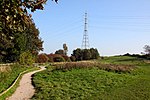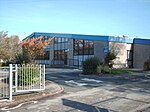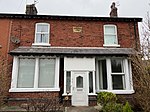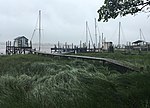Hillylaid Pool

Hillylaid Pool is a water channel running through the Fylde and Wyre areas of Lancashire in England. It is 4.55 miles (7.32 km) long, and it is part of the Fleetwood Peninsula Tributary catchment area.Hillylaid Pool joins the River Wyre at Stanah, shortly after merging with another watercourse to the northwest of Flint's Caravan Park.It has the ability to be pumped at high tide by a pumping station on River Road, beside the entrance to Wyre Estuary Country Park.It was the subject of Wyre River Trust's Hillylaid Pool Wetland Project in 2018. The wetlands were created on the banks of the Wyre at Stanah in 2020, a combined effort of The Rivers Trust and Wyre Rivers Trust.
Excerpt from the Wikipedia article Hillylaid Pool (License: CC BY-SA 3.0, Authors, Images).Hillylaid Pool
River Road, Borough of Wyre Stanah
Geographical coordinates (GPS) Address Nearby Places Show on map
Geographical coordinates (GPS)
| Latitude | Longitude |
|---|---|
| N 53.8815 ° | E -2.978 ° |
Address
River Road
FY5 5FA Borough of Wyre, Stanah
England, United Kingdom
Open on Google Maps









